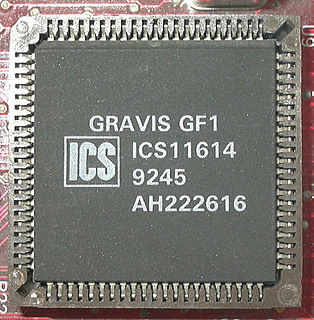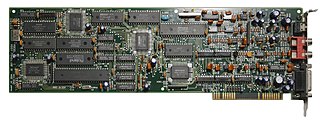
MIDI is a technical standard that describes a communications protocol, digital interface, and electrical connectors that connect a wide variety of electronic musical instruments, computers, and related audio devices for playing, editing and recording music. The specification originates in a paper published by Dave Smith and Chet Wood then of Sequential Circuits at the October 1981 Audio Engineering Society conference in New York City then titled Universal Synthesizer Interface.

A sound card is an internal expansion card that provides input and output of audio signals to and from a computer under control of computer programs. The term sound card is also applied to external audio interfaces used for professional audio applications.
A music sequencer is a device or application software that can record, edit, or play back music, by handling note and performance information in several forms, typically CV/Gate, MIDI, or Open Sound Control (OSC), and possibly audio and automation data for DAWs and plug-ins.

Sound Blaster is family of sound cards designed by Singapore-based firm Creative Technology Limited, also known by the name of its United States subsidiary, Creative Labs. Sound Blaster sound cards were the de facto standard for consumer audio on the IBM PC compatible system platform, until the widespread transition to Microsoft Windows 95, which standardized the programming interface at application level, and the evolution in PC design led to onboard audio electronics, which commoditized PC audio functionality. By 1995, Sound Blaster cards had sold over 15 million units worldwide and accounted for seven out of ten sound card sales.

The game port, originally introduced on the Game Control Adapter, is a device port that was found on IBM PC compatible and other computer systems throughout the 1980s and 1990s. It was the traditional connector for joystick input, and occasionally MIDI devices, until phased out by USB in the late 1990s.

CV/gate is an analog method of controlling synthesizers, drum machines and other similar equipment with external sequencers. The control voltage typically controls pitch and the gate signal controls note on-off.

The Roland JX-3P is a synthesizer produced by Roland Corporation of Japan from 1983-1985. The "3P" in its name refers to "Programmable Preset Polyphonic". It is notable as one of the company's first synthesizers to incorporate a MIDI interface.

Gravis UltraSound or GUS is a sound card for the IBM PC compatible system platform, made by Canada-based Advanced Gravis Computer Technology Ltd. It was very popular in the demo scene during the 1990s.

The MPU-401, where MPU stands for MIDI Processing Unit, is an important but now obsolete interface for connecting MIDI-equipped electronic music hardware to personal computers. It was designed by Roland Corporation, which also co-authored the MIDI standard.

The Roland MT-32 Multi-Timbre Sound Module is a MIDI synthesizer module first released in 1987 by Roland Corporation. It was originally marketed to amateur musicians as a budget external synthesizer with an original list price of $695. However, it became more famous along with its compatible modules as an early de facto standard in computer music. Since it was made prior to the release of the General MIDI standard, it uses its own proprietary format for MIDI file playback.

A sound module is an electronic musical instrument without a human-playable interface such as a piano-style musical keyboard. Sound modules have to be operated using an externally connected device, which is often a MIDI controller, of which the most common type is the musical keyboard. Controllers are devices that provide the human-playable interface and which may or may not produce sounds of its own. Another common way of controlling a sound module is through a sequencer, which is computer hardware or software designed to record and play back control information for sound-generating hardware. Connections between sound modules, controllers, and sequencers are generally made with MIDI, which is a standardized protocol designed for this purpose, which includes special ports (jacks) and cables.

The Roland LAPC-I is a sound card for IBM PC compatible computers produced by Roland Corporation. It basically consists of a MT-32-compatible Roland CM-32L and a MPU-401 unit, integrated onto a single full-length 8-bit ISA card. In addition to normal Roland dealers aimed at musicians, it was distributed in the United States by Sierra On-Line in 1989 for use with the company's games. The MSRP of the card was around US$425.

The discontinued Roland MC-909 Sampling Groovebox combines the features of a synthesizer, sequencer, and sampler, with extensive hands-on control of both the sound engine and the sequencing flow. It was intended primarily for live performance of pre-programmed patterns consisting of up to 16 tracks of MIDI data. It was released by Roland Corporation on October 8, 2002. This product was announced at the AES Fall Convention in 2002. It is the direct successor to the Roland MC-505, and is the predecessor to the Roland MC-808. It was developed from the blueprint of Roland's own "Fantom" workstation and uses the same structure and operating system, with some differences regarding the Patterns section, not implemented in the Fantom.

DCB was a proprietary data interchange interface by Roland Corporation, developed in 1981 and introduced in 1982 in their Roland Juno-60 and Roland Jupiter-8 products. DCB functions were basically the same as MIDI, but unlike MIDI, DCB could provide note on/off, program change and VCF/VCA control only. DCB-to-MIDI adapters were produced for a number of early Roland products. The DCB interface was made in 2 variants, the earlier one used 20-pin sockets and cables, later switching to the 14-pin Amphenol DDK connector vaguely resembling a parallel port.
The Roland SC-55 is a GS MIDI sound module released in 1991 by Roland. The SC-55 was the first sound module to incorporate the new General MIDI standard. It was the first in the Roland Sound Canvas series.

The Roland XP-30 is a 61-key, 64-voice expandable synthesizer. Released in 1999, it was produced until 2002. Based on the acclaimed mid-90s JV sound engine built around a 32-bit RISC processor, it is considered to be the best value-for-money of all of the Roland JV and XP series synthesizers.

The Sound Blaster 16 is a series of sound cards by Creative Technology. They are add-on boards for PCs with an ISA or PCI slot.

The Wave Blaster was an add-on MIDI-synthesizer for Creative Sound Blaster 16 and Sound Blaster AWE32 family of PC soundcards. It was a sample-based synthesis General MIDI compliant synthesizer. For General MIDI scores, the Wave Blaster's wavetable-engine produced more realistic instrumental music than the SB16's onboard Yamaha-OPL3.

The Roland SC-7 General MIDI Sound Module is a stand-alone MIDI synthesizer module by Roland Corporation. It was released in 1992. It supports the General MIDI System and can also be used as a MIDI interface for a computer. The Roland SC-7 provides the basic (capital) Roland Sound Canvas sounds in a compact design for stand-alone, IBM PC/AT or Apple Macintosh computer use.
The Roland JX-305 Groovesynth synthesizer was produced in 1998 by Roland. It is very similar to a Roland MC-505 with an additional set of 61 keys. The keyboard is sensitive to velocity and has channel aftertouch. This keyboard was aimed at producers of dance and trance music and was during the late 90s also popular for live performances.















